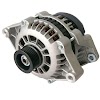Methods of Improving Commutation
There are two methods of improving commutation i.e. of making current reversal in the short circuited coil as sparkles as possible. They are:
(i) Resistance commutations.
(ii) E.M.F commutation (it is done with the help of brush lead or interlopes).
(i) Resistance commutations.
This method of improving commutation consists of replacing low resistance carbon brushes by comparative high resistance carbon brushes.
The current I in coin A has two paths to reach the brush. The first part is straight from segment ‘b’ to the brush and the other path is via short-circuited coil B to segment ‘c’ then to brush. If the copper brushes (low resistance) are used, the current follow the first path but not the second loner path because.
(i) The first path resistance will increase due to diminishing area of contact of brush with segment ‘b’ and because
(ii) Resistance of second path will decrease due to rapid increasing contact area of segment ‘c’ with the brush.
The main cause of commutation is the self induced e.m.f (reactance voltage), so high resistance carbon brushes alone do not give a sparkles commutation, but they help in obtaining it. Another advantage of carbon brushes is that, they lubricate and polish the rotating commutator. The carbon brushes causes voltage drop due to high contact resistance (approximately 2V).
Advantages of carbon brushes.
I) Improves the Commutation.
ii) Lubricate & Polish the commutation.
iii) Easily available in the market.
iv) Economical.
Dis advantages of carbon.
i) causes voltage drop due to high contact resistance.
ii) Needs to be replaced due to wear.
E.M.F Commutation
In the method, arrangement is made to neutralize the reactance voltage by producing a reversing e.m.f in the short-circuited coil. If reversing e.m.f. is made to be exactly equal and opposite to reactance voltage, the current in short-circuit coil will reverse quickly, which results in sparkles commutation. The reversing e.m.f. may be produced in two ways (i) either by giving the brush a forward lead sufficient enough to bring the short-circuited coil under the influence of next pole of opposite polarity or (ii) by using interpoles.
The first method was used in early machines but now it has been ruled-out due to many other difficulties it brings along with it.










0 Comments